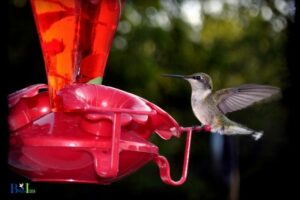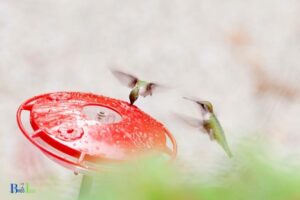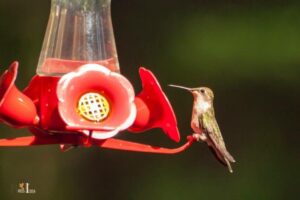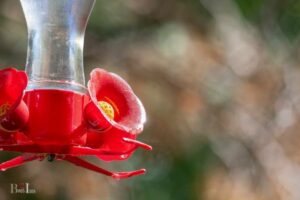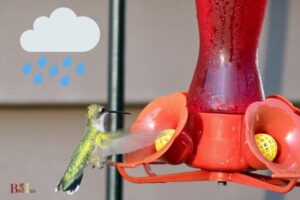How to Feed a Hummingbird Without a Feeder: Variety!
To feed a hummingbird without a feeder, you can use a homemade solution of sugar and water, provide a variety of flowering plants, or offer some fruit.
Hummingbirds are attracted to sources of nectar, and while feeders are a popular way to provide this for them, there are alternative methods for feeding these tiny birds.
By offering a sugar-water solution, planting flowers, or providing fruit, you can cater to their dietary needs and attract hummingbirds to your garden.
Attracting hummingbirds to your garden can be a rewarding experience, as these tiny creatures are fascinating to observe.
By offering a sugar-water solution, providing flowering plants, or giving them fruit, you can create a welcoming environment for hummingbirds without the need for a traditional feeder.
Just remember to keep the feeding area clean and the food sources fresh for the health and safety of your winged visitors.
5 Methods: How to Feed a Hummingbird Without a Feeder
| Method | Description | Materials Needed | Steps |
| Hand Feeding | Offering nectar directly from your hand to attract and feed hummingbirds. | Sugar, water, small container or spoon, red nail polish (optional) | 1. Mix 1 part sugar and 4 parts water in a small container.<br> 2. Hold the container or spoon filled with nectar steady in your hand, near flowers or where hummingbirds frequent.<br> 3. Optionally, add a touch of red nail polish on your fingernails or the container to attract the birds. |
| Hanging Cup | A simple open cup designed for hummingbirds to drink nectar from. | Small shallow cup, string or wire, sugar, water, red ribbon (optional) | 1. Mix 1 part sugar and 4 parts water in the cup. 2. Attach string or wire to the cup and hang it near flowers or where hummingbirds frequent. 3. Optionally, add a red ribbon to the string or cup to attract the birds. |
| Fruit Feeding | Offering natural food sources for hummingbirds through fruit. | Overripe fruit (banana, melon, or papaya), flat dish, small stick or branch | 1. Peel and mash overripe fruit in a flat dish. 2. Place a small stick or branch for the hummingbirds to perch on near the fruit. 3. Set out the dish in an area where hummingbirds frequent. |
| Flower Planting | Growing nectar-rich flowers that naturally attract and feed hummingbirds. | Nectar-rich flowering plants (e.g., trumpet vine, bee balm, salvia, fuchsia) | 1. Choose flowers that are native to your region and known to attract hummingbirds 2. Plant the flowers in your garden or in pots near windows or patios. 3. Ensure the plants get proper sun, water, and care for optimal blooming. |
| Sponge Feeding | Providing nectar through an absorbent sponge for hummingbirds to drink from. | Natural sponge, small dish, string, sugar, water, red ribbon (optional) | 1. Mix 1 part sugar and 4 parts water in a small dish. 2. Cut a natural sponge into a small piece and soak it in the nectar. 3. Attach the sponge to a string and hang it near flowers or where hummingbirds frequent. 4. Optionally, add a red ribbon to the string or sponge to attract the birds. |
Key Takeaway
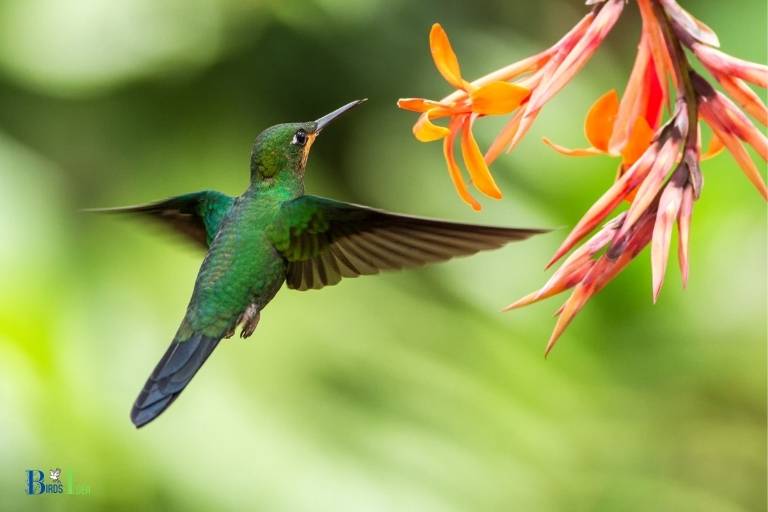
Five Facts About: Feed a Hummingbird Without a Feeder
Understanding Hummingbirds’ Food And Feeding Habits
Hummingbirds are fascinating creatures that can be found across north and south america, from alaska to tierra del fuego. They are a delight to watch, as they hover in mid-air and drink nectar from flowers.
While many people use feeders to attract hummingbirds to their yards, there are ways to feed hummingbirds without using a feeder.
In this blog post, we will explore how to understand hummingbirds’ food and feeding habits, including what they eat in their natural habitat, how often they need to eat, and how feeding behavior changes during migration.
What Do Hummingbirds Eat In Their Natural Habitat?
Hummingbirds feed primarily on nectar, which is a sweet liquid produced by flowers to attract pollinators. They are also known to eat insects and spiders, particularly during nesting season when they need extra protein to feed their young.
Some of their favorite flowers include:
- Red hot poker
- Trumpet vine
- Salvia
- Scarlet sage
- Bee balm
- Honeysuckle
How Often Do Hummingbirds Need To Eat?
Hummingbirds have a very high metabolism and need to eat frequently to keep up their energy levels. In general, they need to eat every 10-15 minutes during the day.
However, their feeding schedule may vary depending on the time of day and the season.
During nesting season, female hummingbirds may eat as much as half their body weight in nectar and insects each day to produce enough milk to feed their chicks.
How Does Feeding Behavior Change During Migration?
Hummingbirds are migratory birds, and their feeding habits change during their migration. Before migration, they will spend more time eating and drinking to build up their energy reserves.
During migration, they will rely more on flower nectar and less on insects, as insects are harder to find during long flights.
When they arrive at their destination, they will spend more time feeding on insects to regain their strength after the long journey.
Understanding hummingbirds’ food and feeding habits can help you provide them with a suitable food source in your yard without using a feeder.
By planting the right flowers and providing food sources, you can attract hummingbirds to your yard and provide them with the necessary energy to survive and thrive.
Creating A Hummingbird-Friendly Garden
Hummingbirds are not only beautiful but also important pollinators for plants. If you want to help these amazing little creatures thrive, you can create a hummingbird-friendly garden in your outdoor space.
Here are some tips on how to turn your garden into a haven for hummingbirds.
What Plants Attract Hummingbirds?
Hummingbirds love certain flowers and plants that are high in nectar.
Here are some plants that can attract hummingbirds to your garden:
- Bee balm
- Salvia
- Cardinal flower
- Trumpet vine
- Butterfly bush
- Honeysuckle
- Penstemon
- Fuchsia
- Columbine
- Red hot poker
By incorporating these plants into your garden, you can create a tempting environment that hummingbirds won’t be able to resist.
How To Arrange Flowers And Feeders For Maximum Access?
To maximize access for hummingbirds, arrange your flowers and feeders in a way that is both visible and easily accessible.
Here are some things to keep in mind:
- Place feeders and flowers in an open area where hummingbirds can easily spot them.
- Use bright, bold colors to attract attention and help hummingbirds find the food source.
- Make sure the feeders and flowers are easily accessible and at varying heights to accommodate different species of hummingbirds.
- Keep the flowers and feeders clean and well-maintained to ensure that they remain a healthy food source for the hummingbirds.
Which Colors And Smells Attract Hummingbirds?
Hummingbirds are attracted to bright, bold colors and strong fragrances.
Here are some colors and smells that can attract hummingbirds:
- Red: Hummingbirds are especially attracted to the color red and can see it from a long distance away.
- Orange: This color is also known to attract hummingbirds, as it resembles the color of many nectar-rich flowers.
- Sweet, fragrant smells: Hummingbirds are drawn to sweet, fragrant aromas. You can plant flowers like lavender, rosemary, and mint to attract hummingbirds with their scent.
By incorporating these colors and smells into your garden, you can create a welcoming environment that hummingbirds will love.
Overall, creating a hummingbird-friendly garden is a simple and rewarding way to help these amazing creatures thrive. With just a few simple tips, you can create a habitat that hummingbirds will flock to.
Natural Hummingbird Food Recipes
Hummingbirds are fascinating creatures that delight us with their bright plumage and acrobatic flights.
While feeding them with a hummingbird feeder is the most common way to attract them to your yard, there are natural alternatives for those who prefer not to use one.
In this post, we will learn how to feed a hummingbird without a feeder and focus on natural hummingbird food recipes.
How To Make Nectar With Sugar And Water?
Hummingbirds primarily feed on the nectar produced by flowers, which is a rich source of energy for their high metabolism. Luckily, you can easily make a substitute for nectar with two simple ingredients: white granulated sugar and water.
Follow these steps to make hummingbird nectar:
- Mix four parts of water with one part of white granulated sugar in a saucepan
- Bring the mixture to a boil while stirring until the sugar completely dissolves
- Let the mixture cool down to room temperature before filling the feeder or putting it in natural containers such as flowers
How To Choose The Right Water?
The quality of water is essential for attracting hummingbirds to your garden for feeding.
Follow these tips to ensure that you select the right water:
- Use freshwater. Avoid using distilled or mineral water because it can harm the hummingbirds’ natural digestive process.
- Ensure that the water is clean, filtered, and free from any possible impurities.
How To Store And Serve Nectar To Hummingbirds?
Proper storage and placement of homemade nectar are crucial to feeding hummingbirds successfully.
Follow these guidelines:
- Store leftover nectar in a clean, airtight container in the refrigerator for up to a week.
- Clean the feeder or containers every few days to prevent bacteria buildup.
- Place the feeder or containers in a spot visible to hummingbirds, away from direct sunlight and predators.
Feeding hummingbirds without a feeder is easy and cheap with natural hummingbird food recipes.
Making nectar at home, choosing the right water, and properly storing and serving the nectar are essential steps to attract hummingbirds to your garden and keep them coming back.
Get ready to enjoy the beauty and charm of these tiny wonders in your backyard!
Other Food Options For Hummingbirds
Hummingbirds are fascinating little creatures that leave us mesmerized with their agility and beautiful colors. They are renowned for their love of nectar, but do they have other food options? The answer is yes!
You don’t always need to have a feeder to attract these tiny birds.
Let’s dive into the world of hummingbird food and explore other options for feeding them.
What Other Foods Can Hummingbirds Eat Besides Nectar?
Hummingbirds love nectar, but they also require a variety of nutrients to thrive.
You can supplement their diet with the following food items:
- Insects: Hummingbirds are natural predators and love consuming aphids, spiders, fruit flies, and gnats. You can hang out overripe banana peels or watermelon rinds to attract fruit flies and gnats and watch hummingbirds feast on them.
- Tree sap: Hummingbirds’ beaks are perfect for drilling holes in tree bark to extract sap. By offering a fresh tree sap source, you can provide hummingbirds with essential sugars and nutrients.
- Pollen: Hummingbirds use pollen mainly to supplement their diet with protein. The best flowers to attract hummingbirds are vividly colored and tubular with copious nectar and pollen, such as bee balm, trumpet creeper, and salvia.
- Fruit: Hummingbirds can eat soft or over-ripe fruits. You can offer them diced banana, peeled mango, papaya, or pomegranate. Make sure to use small pieces or thin slices to avoid fruit waste.
How To Offer Fruit And Protein To Hummingbirds?
If you want to add fruit and protein to hummingbirds’ diet, remember:
- Offer fruit and protein in tiny quantities: Hummingbirds can eat only a small amount of fruit to supplement their diet, so make sure you’re not overfeeding them.
- Clean the fruit feeder often: If you’re offering fruits, change them daily and clean the feeder with hot water before refilling it.
- Choose soft fruits: Hummingbirds prefer soft fruits that don’t pose a hazard to their tiny beaks.
How To Avoid Feeding Hummingbirds Harmful Food?
Hummingbirds are tiny creatures, and some foods can harm them.
Here are some foods to avoid:
- Honey: Hummingbirds cannot digest honey correctly, and it can cause fatal infections in their digestive tracts.
- Dried fruits and raisins: They contain yeast, which develops toxins that can kill hummingbirds.
- Food coloring: Food coloring can hurt birds and even cause cancer.
- Nut and seed butter: They can cause choking hazards and get stuck in a hummingbird’s throat.
Hummingbirds are fascinating creatures that bring joy to any garden.
If you’re going to attract them to your garden, choose your food offerings carefully. Remember to keep the food clean, fresh, and in tiny quantities. Happy birdwatching!
FAQ On How To Feed A Hummingbird Without A Feeder
How Do You Attract Hummingbirds Without A Feeder?
What Type Of Sugar Should I Use To Make Hummingbird Food?
How Often Should I Change The Hummingbird Food?
Can I Use A Regular Bird Feeder For Hummingbirds?
Conclusion
After reading this post, you now know that there are many ways to feed hummingbirds without a feeder.
By using natural nectar sources, planting native plants, and hanging sugar water feeders, you can attract hummingbirds to your backyard and provide them with the nutrition they need.
Additionally, by following the tips on placement and maintenance, you can ensure that your feeding area remains safe and hygienic for the hummingbirds.
Remember, when feeding hummingbirds, it is crucial to avoid using red dyes, honey, and artificial sweeteners, which can be harmful to these delicate creatures.
With a little bit of effort and creativity, you too can enjoy the beauty and grace of hummingbirds in your own backyard. Happy birdwatching!


